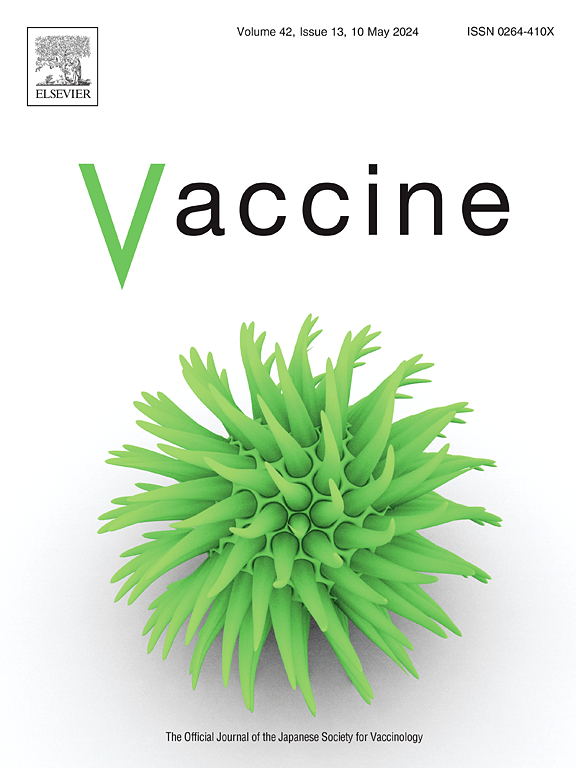一种基于神经氨酸酶的灭活流感病毒疫苗在猪同源攻击后显著减少病毒复制和病理。
IF 4.5
3区 医学
Q2 IMMUNOLOGY
引用次数: 0
摘要
甲型流感病毒(IAV)亚型H1N1、H1N2和H3N2在美国家猪群中流行,每年造成重大经济损失,并构成持续的大流行威胁。全灭活病毒(WIV)佐剂疫苗是控制猪流感的主要对策。这些疫苗的成分与血凝素(HA)菌株和含量相匹配,通常忽略了另一种IAV糖蛋白,神经氨酸酶(NA)。IAV NA具有免疫原性,针对活性位点附近表位的抗体已被证明可以抑制NA的唾液酸酶活性,从而减少病毒的复制和脱落。为了评估由WIV诱导的神经氨酸酶抑制(NAI)抗体保护猪免受含有同源和异源NA的IAV攻击的能力,我们制备了由具有不相关的不匹配H9 HA的病毒组成的WIV,但表达来自两个主要分支(N2-2002A)的NA蛋白。N22002B.2和N22002B.2)目前在美国家猪群中流行。接受两剂H9N2 WIV的猪产生了疫苗特异性神经氨酸酶抑制抗体,当用含有同源NA的野生型H3N2病毒攻击时,与未接种疫苗的对照组相比,上呼吸道的病毒脱落减少,肺部的病毒滴度降低。用含有异源NA的H3N2攻毒的猪鼻拭子和BALF样本中的病毒滴度也降低。总之,这些结果表明,NAI抗体跨系统进化枝交叉保护,减少了病毒在猪体内的复制和脱落。本文章由计算机程序翻译,如有差异,请以英文原文为准。
A neuraminidase-based inactivated influenza virus vaccine significantly reduced virus replication and pathology following homologous challenge in swine
Influenza A viruses (IAV) of subtypes H1N1, H1N2, and H3N2 are endemic in US domestic swine populations and contribute to significant economic losses annually and pose a persistent pandemic threat. Adjuvanted, whole-inactivated virus (WIV) vaccines are the primary countermeasure to control IAV in swine. The compositions of these vaccines are matched for hemagglutinin (HA) strain and content, often ignoring the other IAV glycoprotein, the neuraminidase (NA). The IAV NA is immunogenic and antibodies targeting epitopes adjacent to the active site have been shown to inhibit the sialidase activity of NA thereby reducing virus replication and shedding. To assess the ability of neuraminidase inhibiting (NAI) antibodies induced from WIV administration to protect swine from challenge with IAV containing homologous and heterologous NA, we produced WIV composed of viruses with an irrelevant mismatched H9 HA but expressing NA proteins from two predominant clades (N2–2002A.2 and N2![]() 2002B.2) currently circulating in US domestic swine populations. Pigs that received two doses of H9N2 WIV developed vaccine-specific neuraminidase inhibition antibodies and when challenged with a wild-type H3N2 virus containing homologous NA, displayed reduced virus shedding in the upper respiratory tract and decreased virus titers in the lung compared to unvaccinated controls. Pigs challenged with H3N2 containing a heterologous NA also had reduced virus titers in the nasal swab and BALF samples. Together these results show that NAI antibodies cross-protected across phylogenetic clades and reduced virus replication and shedding in swine.
2002B.2) currently circulating in US domestic swine populations. Pigs that received two doses of H9N2 WIV developed vaccine-specific neuraminidase inhibition antibodies and when challenged with a wild-type H3N2 virus containing homologous NA, displayed reduced virus shedding in the upper respiratory tract and decreased virus titers in the lung compared to unvaccinated controls. Pigs challenged with H3N2 containing a heterologous NA also had reduced virus titers in the nasal swab and BALF samples. Together these results show that NAI antibodies cross-protected across phylogenetic clades and reduced virus replication and shedding in swine.
求助全文
通过发布文献求助,成功后即可免费获取论文全文。
去求助
来源期刊

Vaccine
医学-免疫学
CiteScore
8.70
自引率
5.50%
发文量
992
审稿时长
131 days
期刊介绍:
Vaccine is unique in publishing the highest quality science across all disciplines relevant to the field of vaccinology - all original article submissions across basic and clinical research, vaccine manufacturing, history, public policy, behavioral science and ethics, social sciences, safety, and many other related areas are welcomed. The submission categories as given in the Guide for Authors indicate where we receive the most papers. Papers outside these major areas are also welcome and authors are encouraged to contact us with specific questions.
 求助内容:
求助内容: 应助结果提醒方式:
应助结果提醒方式:


